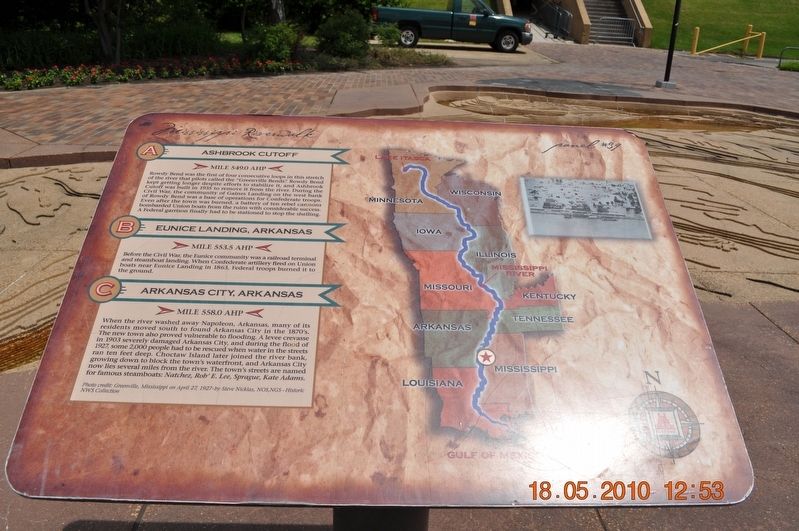Memphis in Shelby County, Tennessee — The American South (East South Central)
Ashbrook Cutoff/Eunice Landing, Arkansas/Arkansas City, Arkansas
Panel #39 Mississippi Riverwalkk
Inscription.
A) Ashbrook Cutoff
Mile 549.0 AHP
Rowdy Bend was the first of four consecutive loops, in this stretch of the river that pilots called the “Greenville Bends.” Rowdy Bend kept getting longer despite efforts to stabilize it, and Ashbrook Cutoff was built in 1935 to remove it from the river. During the Civil War, the community of Gaines Landing on the west bank of rowdy Bend was a bee of operations for Confederate troops. Even after the town was burned, a battery of ten rebel cannons bombarded Union boats from the ruins with considerable success. A Federal garrison finally had to be stationed to stop the shelling.
B) Eunice Landing, Arkansas
Mile 553.5 AHP
Before the Civil War, the Eunice community was a railroad terminal and steamboat landing. When Confederate artillery fired on Union boats near Eunice Landing in 1863, Federal troops burned it to the ground.
C) Arkansas City, Arkansas
Mile 558.0 AHP
When the river washed away Napoleon, Arkansas, many of its residents moved south to found Arkansas City in the 1870’s. The new town also proved vulnerable to flooding. A levee crevasse in 1903 serenely damaged Arkansas City, and during the flood of 1927, some 2,000 people and to rescued when water in the streets ran ten feet deep. Choctaw Island later joined the river bank, growing down to block the town’s waterfront, and Arkansas City now lies several miles from the river. The town’s streets are named for famous steamboats: Natchez, Rob’ E. Seem Sprague, Kate Adams.
Photo Credit: Greenville, Mississippi on April 27, 1927-by Steve Nicklas, NOS, NGS, Historic NWS Collection
Erected by Mississippi Riverwalk. (Marker Number 39.)
Topics. This historical marker is listed in these topic lists: Settlements & Settlers • War, US Civil • Waterways & Vessels.
Location. 35° 8.968′ N, 90° 3.507′ W. Marker is in Memphis, Tennessee, in Shelby County. Marker can be reached from Island Drive, 0.8 miles south of West A.W. Willis Avenue when traveling south. Located in Mud Island River Park. Touch for map. Marker is at or near this postal address: 125 N Front St, Memphis TN 38103, United States of America. Touch for directions.
Other nearby markers. At least 8 other markers are within walking distance of this marker. The Mississippi Riverwalk (here, next to this marker); Ohio River (here, next to this marker); Cairo, Illinois (here, next to this marker); Islands No. 2, 3, and 4 / Fort Jefferson, Kentucky / Bird’s Point, Missouri (here, next to this marker); Island No. 5 (Wolf Island)/Belmont, Missouri/Columbus, Kentucky (here, next to this marker); Donaldson Point, Missouri/Island No. 8/Hickman, Kentucky/Dorena Crevasse (here, next to this marker); New Madrid, Missouri/Cates Casting Field/Island No. 10 (here, next to this marker); Tiptonville, Tennessee/Bixby Towhead (here, next to this marker). Touch for a list and map of all markers in Memphis.
Also see . . . Napoleon, Arkansas. Napoleon is a "drowned town" in Desha County, Arkansas, United States, near the confluence of the Arkansas and Mississippi rivers. Once the county seat, Napoleon was doomed when in 1863, a channel was cut through the soft land that inadvertently directed the river waters toward the town. It was finally submerged in 1874 when the banks of the Mississippi River burst through and destroyed the last of the once-thriving river port town.[1] (Submitted on March 27, 2018, by Sandra Hughes Tidwell of Killen, Alabama, USA.)
Credits. This page was last revised on March 29, 2018. It was originally submitted on March 27, 2018, by Sandra Hughes Tidwell of Killen, Alabama, USA. This page has been viewed 302 times since then and 36 times this year. Photo 1. submitted on March 27, 2018, by Sandra Hughes Tidwell of Killen, Alabama, USA. • Bernard Fisher was the editor who published this page.
Editor’s want-list for this marker. Wide shot of marker and its surroundings. • Can you help?
